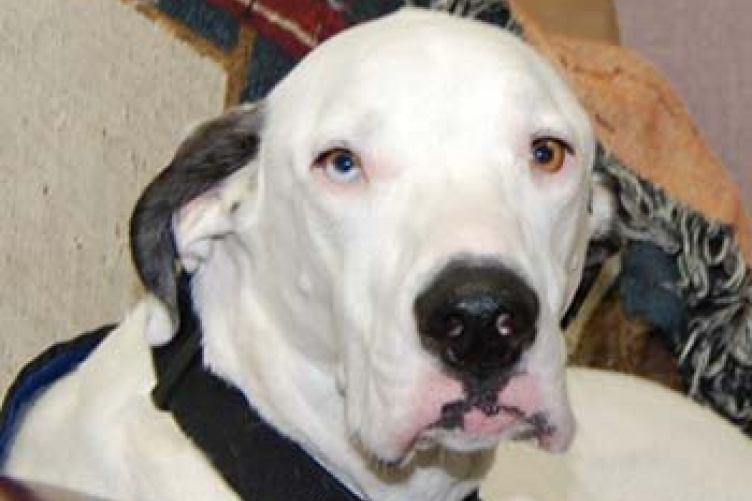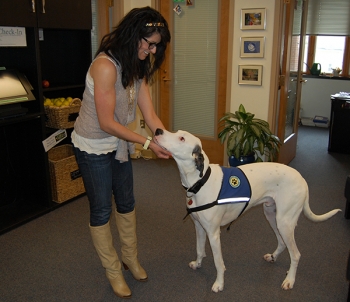
Before Hamilton Caplan could come to UNH, he had to go to school.
An 85-pound, 3-foot-6 Great Dane mix, Hamilton is UNH Health Services’ first therapy dog. His owner, Maria Caplan, the nutrition educator at Health Services, adopted him as a puppy four years ago from a shelter in Texas, where she and her husband were then living.
“He was so spectacular looking,” Caplan says, recalling her first impression of the not-yet-giant white, square-headed dog with different colored eyes. “His owners dropped him off on Friday and we picked him up on Saturday.”
Hamilton turned 4 in April, around the same time Caplan began bringing him to campus. Once a week, the pair would venture, out and when students approached them, as they always did, Caplan would take the opportunity to talk about the many programs Health Services has to offer.
But before then, there was his schooling.
 |
“I had been looking for a way to give back, and he was so social, it seemed like a good fit,” Caplan says of the decision to train Hamilton as a therapy dog.
Last fall she enrolled him in a six-week Canine Good Citizen course, sponsored by the American Kennel Club and aimed at fostering owner responsibility and good manners for dogs. At the end of the course, Hamilton had to pass an exam, proving he could do such things as walk calmly at Caplan’s side, be around other dogs without getting distracted, and sit and stay put unattended for at least 30 seconds.
“He did fantastic,” Caplan says. “It’s like he was made for this.”
Next came certification as a therapy dog through Pet Partners, a non-profit group that believes companion animals—dogs, cats, rabbits, you name it—better peoples’ lives. To achieve the accreditation, Caplan had to get trained, too.
“You have to work as a team,” she says. In fact, before she could even register Hamilton for the Pet Partners program, she had to take a handler’s course to learn the skills needed to take the Great Dane into hospitals, nursing homes, classrooms, and other places dogs are not typically found.
At the end of the course, Hamilton had to pass another test, this one in a hospital-like environment. People yelled at him; came up and grabbed him, hugged him, and watched how he reacted. He was hit by wheelchairs and walkers. He couldn’t lunge for things they put on the floor. He couldn’t be rambunctious or curious-dog-ish.
All of that training led to him fitting right in at UNH, where he was constantly being fawned over by strangers. Soon, Caplan was bringing him to work three days a week. The pair would venture out for a lunchtime walk, to a Health Services program, or to visit outside the dorms.
“The response was immediate,” Caplan says. “Everywhere we went, there were hands all over him and he was just loving it.”
The students were loving it, too. Hamilton was helping to relieve their stress, providing emotional comfort—something studies have shown contributes to a person’s state of well-being by reducing anxiety, lowering blood pressure, releasing endorphins, and easing tension.
“This kind of therapy is so simple. It’s an instantaneous, non-stigmatizing way to get relief from stress,” Caplan says. “For a lot of students who have dogs at home or had them growing up, Hamilton helps bring back a sense of normalcy. The simple kind act of a dog stepping into their world for even 10 minutes can make a difference. They’re petting him and not thinking of anything else.”
If all goes according to plan, Hamilton will be back at Health Services in the fall on a regular basis. Caplan wants to train students to work with him so she can focus on her job.
“He’s very calm; he’ll be fine with students taking him around,” Caplan says. Her only caution is that they can’t be in a hurry.
“It takes forever to get anywhere with him,” Caplan says. “It’s like walking around campus with Brad Pitt.”
-
Written By:
Jody Record ’95 | Communications and Public Affairs | jody.record@unh.edu




















































